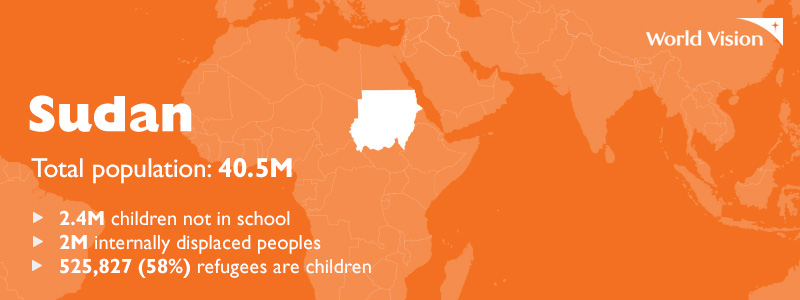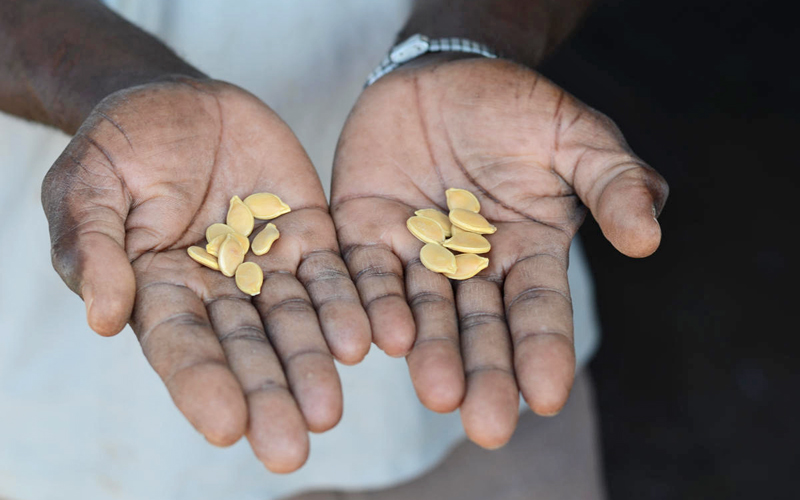Childhood Under Assault
Part 10: Nesadin, Sudan
Girls and boys deserve to grow up free from abuse, exploitation and violence. But in the world’s most dangerous places, childhood is frequently the first casualty. Here is Nesadin’s story, the final in our 10-part series.
Agriculture was in his father’s blood.
For as long as he’d been alive, the soil of the boy’s family farm had been pushing up green, tender shoots. They grew big and tall – staple crops like corn and millet. People in the community ate and were filled.
The farm was in Darfur, in the western part of Sudan. And the boy’s name was Nesadin.
Watering with tears
Nesadin’s grandfather and great grandfather had been market gardeners and his father had inherited the passion.
He loved working the land – that beloved soil of home. His children learned their colours by the palette of the fields. The brown of the earth. The yellow of the corn. The blue of the sky. And so many shades of green.

Then one day in 2011 everything that had once been beautiful turned ugly. And a new colour was introduced to the landscape.
It was blood red.
Armed militia descended on Nesadin’s community. There was shouting…barking of orders. The sounds of their victims’ screams and cries. Their pleading for mercy.
“We don’t know why they started attacking us,” says Nesadin’s father, “but during those attacks, people were killed.”
“They burned the houses. They raped the girls. They killed my brothers and sisters.”
People were violently cut down, even as the plants grew all around them. Remembering, eight years later in a refugee camp in Kenya, Nesadin’s dad stands silent for a moment.
Then doubles over, sobbing.
 Just two good things
Just two good things
We don’t know how much of the horror Nesadin witnessed for himself.
He was about three at the time – too small to recall, he says. Children’s minds often push such impressions deep down inside.
Still, the horrific stories have become part of Nesadin’s family’s oral history. Along with what happened next.
Nesadin’s dad gathered his kids and ran, grabbing just one small possession. Besides his children, it was the only good thing he could lay eyes on in the dizzying horror.
A small packet of seeds.

Of all the things he could have chosen, why did Nesadin’s dad pick these? Maybe he was hoping to start again – wherever the family’s flight took them. Or maybe they were simply a memento of life before the nightmare.
Dormant hope
For a long time, the seeds slept in the father’s bundle.
This dad had other things to think about. The immediate need to find safety for his family of ten children. His kids’ hungry bellies. Their dwindling energy. The need for shelter, clothing and medicine.
And there was something else to seek at all costs. Something that, like seeds, could grow a future for his children. It was education. A chance for the kids to attend school.
The family arrived in a city they hoped would be peaceful. They had fled south, crossing the border into the world’s youngest country – the newly independent South Sudan – to the capital city, Juba.

The city offered schooling for Nesadin and his brothers and sisters. But in many African countries, even public school comes with costs. Fees. Uniforms. School supplies like paper and pencils.
A new battleground
So Nesadin’s dad laid aside his dreams of farming – and picked up shoemaker’s tools. For two years, he repaired other people’s shoes. Head down. Mind on the task.
Fighting back all memories of the past. Sunlight filtering through the crops. That joyful feel of rich soil in his hands. It was impossible to remember for long without the horror tearing through again.
By 2013, Nesadin’s father was forced to look around him. The city of Juba, where the family now lived, had become a battleground of its own. Old scores not settled at the government level brewed up angrily. And the fight for power continued to escalate. Violent conflict erupted.
Nesadin’s family was in danger again. So once again, father grabbed his children to flee – reaching for that old pack of seeds.
Daring to dream
The family fled south-east, this time to neighbouring Kenya. In 2014, they were registered as refugees in a camp with a population of 160,000 souls.

They moved into one of the make-shift structures. And the father enrolled his children in the camp schools.
It was calmer at the camp, safer. There were chances to learn. But no opportunities to work outside camp boundaries, as it’s illegal for refugees in Kenya.
This made Nesadin’s hard-working dad miserable. The father didn’t like relying on handouts. After a month, he could no longer stand it.
“My father was tired of relief food. He wanted to work,” Nesadin said.
His father noticed that the camp was overgrown on one border, with overgrown weeds and thorn trees. An idea took root. He and his sons began clearing the land for planting. He even dug a small well by hand.

“I took those seeds from Darfur, and planted them,” the father remembers. After a few months of careful weeding and watering, the tiny seeds had become a vibrant field of okra.
New challenges
It would be wonderful to say that this one packet of seeds resurrected this farming family’s livelihood and future.
But in conflict zones, real life rarely works that way.
Drought gripped Kenya the following year, and the hand-dug well ran dry. The family watched helplessly as the crops withered and died. For the second time, they were forced to abandon the land – and wait endlessly for rain that never came.
“We went back again to eating food rations given to us at the camp,” Nesadin says. Their dreams lay fallow once again.
Then something happened that the family hadn’t expected. World Vision installed a 72-metre borehole in the camp, which tapped into a deep, underground water source. The solar-powered generator turned the blazing sun into endless energy.
World Vision helped organize 200 people to share a seven-acre piece of land. The group was made up of refugees and members of the Kenyan ‘host community’. Together, citizens and refugees would reap the benefits of the hard work to come.
A bounty of green
The produce from the first crop was enormous.
And with the profit, the group bought a second-hand motorcycle, to get their harvest to the marketplace. Things were going so well that they planned to expand the field to 20 acres, involving more and more refugee families who’ve experienced the unthinkable.

The benefits of gardening go far beyond food and income says Phiona Koyiet, a counselor and psychologist who works for World Vision in Kenya – especially for refugees who have experienced traumatic events,
“When you’re gardening or digging, you’re relieving your stress. It’s a good coping mechanism. It helps build personal resilience,” she says.
Live and pride
Not surprisingly, Nesadin’s dad quickly signed up to join the gardening group. He still had seeds left over, harvested from his earlier farming venture in the camp.
“Our father is producing more crops than any other garden member,” says Nesadin with pride.
“And I like the food from our farm. I eat cowpeas, okra and watermelon.” There’s also cucumber, tomatoes and pumpkins. Could it be Nesadin had forgotten what they tasted like, after so many years without?
When Nesadin’s school breaks, he happily joins his dad in the garden. Working the earth. Nurturing the sprouts with fresh water. Feeling that joyful weight of produce in his hands.

He’s a brand-new generation of farmer.
The way the boys joke with their dad, admire his dedication to the community garden and share their aspirations to be farmers, it’s clear that gardening is doing more than putting food on the table.
Everyone feels good while they’re gardening. The results are both filling – and immensely fulfilling.
“I feel so nice when I eat this type of a meal,” says Nesadin. “I know the food has benefits like vitamins. I haven’t been sick since eating this way.”
It’s heartwarming to hear what he says next. Something that shows Nesadin’s life has moved beyond bare subsistence. The kind of comment we hear from kids in Canada all the time. The words of a boy who’s no longer hungry every single moment of the day.
“But I do not like the pumpkin.”
 Nesadin (in yellow and blue) loves working with his father (top right) and two of his brothers. Farming is once again a family affair! Photo: Mark Nonkes
Global poverty is in retreat but has become more concentrated in the world’s darkest places. Over the next decade, more than 80 per cent of the world’s poorest children and families will live in the most dangerous places where lives and futures are threatened by conflict and disaster. Join the movement and take action against injustice. Learn how you can help.
Nesadin (in yellow and blue) loves working with his father (top right) and two of his brothers. Farming is once again a family affair! Photo: Mark Nonkes
Global poverty is in retreat but has become more concentrated in the world’s darkest places. Over the next decade, more than 80 per cent of the world’s poorest children and families will live in the most dangerous places where lives and futures are threatened by conflict and disaster. Join the movement and take action against injustice. Learn how you can help.